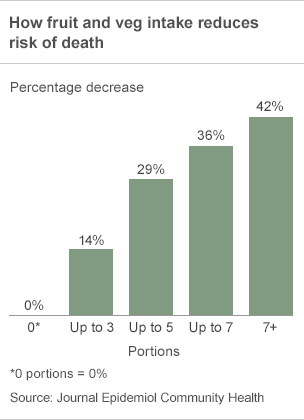What Quantity of Vegetables Should We Be Eating?
If you live in the UK you probably heard the news last week that a study found that eating seven or more portions of vegetables a day is healthier than the current minimum recommendation of five a day.
You can see from the graph that even though the news coverage featured 7 portions a day, the benefits continue to increase if you eat more than 7 portions a day.
This study came out hot on the heels of me reading The Wahls Protocol. One of the central recommendations of The Wahls Protocol is nine cups of vegetables and fruit a day (three cups green leafy, three cups colourful and three cups sulphur rich*). This is what Dr Wahl’s research showed provided the correct nutrition for cell and brain function.
Both pieces of research point in the same direction; increasing the vegetable content of our diet is good for health, and it is particularly important when our body is trying to heal itself. This is not surprising given that vegetables contain all kinds of micro-nutrients (vitamins, minerals and phytochemicals) as well as being a source of carbohydrates and fibre.
If you’re eating a typical western diet and you have limited energy then the idea of nine cups of vegetables a day is extremely daunting. So I recommend that you don’t aim that high, at least to start with. The graph above shows that each extra portion of vegetables you eat in a day has health benefits, so that’s a good place to start. Aim to eat one additional portion of vegetables per day. Once you’re managing that try adding another one in, and just keep going. You may not reach nine, but each extra one will help provide the nutrients your body needs to heal itself. I have been monitoring my vegetable consumption and I think I typically manage 6-7 cups per day. I have experimented with nine cups, but at the moment I’m happy with my progress and have decided that the additional effort to maintain nine cups a day is not a priority.
Easy Ways to Increase Your Vegetable Intake
Vegetables generally require a bit of preparation, but when I was very low on energy I worked out a few ways to get them in my diet with minimal effort. I’ve written about some of this in Feeding Hungry Kids (and Husbands), but a little reminder can be useful.
- Buy ready washed salad and spinach. This was/is the simplest way for me to add green leafy vegetables to any meal.
- Buy ready prepared fresh vegetables. I keep bags of carrot batons in the fridge which are easy to add to salads or for a quick snack with hummus.
- Use frozen vegetables: These are generally frozen soon after picking and hence have high nutrient content, they are already prepared and can be cooked quickly in the microwave or a steamer on the stove. I have also added them to slow cooker meals. If you add them at the start of cooking they tend to end up very mushy, so if your cognitive and physical function allows it’s best to add them near the end, but for a while our family had to make do with mushy slow cooked frozen vegetables.
Cooking Methods
After years of cooking whatever we received in our organic vegetable box (at first I used to have to look up what some of the stranger vegetables were on the internet) I have concluded there are a few main ways to prepare vegetables: the traditional steam/boil; stir fry with ginger and garlic; roast in the oven; or add to soups or stews. Name a vegetable and I’ll bet that by using one of those methods you’ll end up with a delicious dish.
* Here’s a list of some vegetables and fruits that fit into Dr Wahl’s 3 categories.
Green Leafy Vegetables
- Spinach
- Kale
- Beet greens
- Pak Choy and other asian greens
- Chard, all colours
- Chicory
- Collard Greens
- Coriander leaves
- Dandelion leaves
- Lettuce – not iceberg
- Mustard greens
- Parsley
- Radicchio
- Watercress
- Wheatgrass
Colourful Vegetables and Fruit – mix your colours, eat the rainbow.
Green
- Asparagus
- Artichokes
- Avocados
- Green Beans
- Green Cabbage
- Celery
- Courgette (skin on)
- Cucumbers (skin on)
- Green Grapes
- Peas
- Kiwi
- Limes
- Melons (honeydew)
- Okra
- Green Olives
- Green Peppers
Red
- Beetroot
- Blood Oranges
- Red Cabbage
- Cherries
- Cranberries
- Red Grapefruit
- Red Grapes
- Red Pepper
- Pomegranate
- Radishes
- Raspberries
- Rhubarb
- Strawberries
- Tomatoes
- Watermelon
Blue/Purple/Black
- Ariona Berries
- Aubergine
- Blackberries
- Blueberries
- Dates
- Elderberries
- Black or Purple Grapes
- Figs
- Purple Kale
- Black Olives
- Plums
- Prunes
- Raisins
Yellow/Orange
- Apricots
- Carrots
- Grapefruit
- Lemon
- Mango
- Nectarine
- Oranges
- Papaya
- Peach
- Orange and Yellow Pepper
- Pineapple
- Pumpkin
- Squash
- Sweet Potato and Yams
- Tangerines
Sulphur Rich Vegetables
- Asparagus
- Pak Choy
- Broccoli
- Brussel sprouts
- Cabbage
- Cauliflower
- Chives
- Collard Greens
- Daikon
- Garlic
- Kale
- Leeks
- Mushrooms
- Onions
- Radishes
- Rutabagas
- Spring Onions
- Shallots
- Turnips and Turnip Greens


Pingback: Green Smoothies | Eat 4 ME
Pingback: How I went from lying down all day to cycling the Coast to Coast | Eat 4 ME